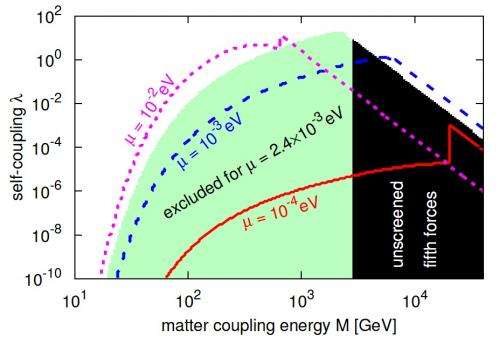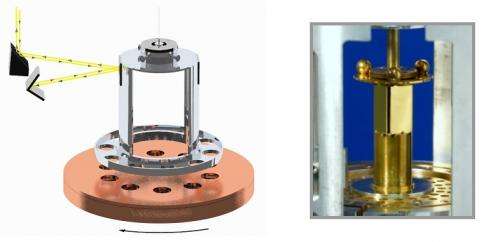January 28, 2013 feature
Can dark energy be explained by symmetrons?

(Phys.org)—A field that permeates the universe and gives rise to a new force, or "fifth force," between massive objects may be a candidate for dark energy and an explanation for why the expansion of the universe is accelerating. This field, called the symmetron field, is so named because it has a symmetry in regions of high density, while in regions of low density, such as a vacuum, the symmetry is broken and the field mediates the new force.
Currently, the symmetron concept is purely theoretical. But in a new study, physicist Amol Upadhye at Argonne National Laboratory in Argonne, Illinois, has calculated that a previously unexplored symmetron regime near the dark energy scale will give rise to a fifth force at submillimeter distances. He proposes that short-range gravity experiments can search for the fifth force at these distances and possibly reveal if dark energy is in fact a symmetron field.
"Much of my work has focused on chameleon dark energy theories, and I really only started thinking about symmetrons last summer," Upadhye told Phys.org. "Modern experimental techniques and technologies have advanced enough to search for new physics at distances of interest for dark energy theories."
As Upadhye explained, a symmetron field could fulfill the role of dark energy by acting as a negative pressure.
"Dark energy in general can be described by a constant (or slowly varying) vacuum energy density, such as that due to a field whose potential is minimized at a small, positive value," he said. "In the presence of such an energy density, Einstein's equation of General Relativity (GR) predicts that the universe will expand at an accelerating rate. In GR, pressure gravitates; positive pressures contribute to the decelerating expansion of the universe. Dark energy acts as a negative pressure which leads to an accelerating expansion.
"The simplest model of a dark energy is Einstein's cosmological constant, a constant vacuum energy density which explains all available data. The big question in cosmology is whether or not the dark energy is just a cosmological constant. Alternative theories predict that the vacuum energy density evolves with time, or that new ('fifth') forces exist between known particles.
"Since GR is very accurate in the laboratory and the solar system (regions in which the density is much higher than the cosmic mean), any fifth force must be 'screened' at high densities. The symmetron mechanism is one way to screen fifth forces."
In theory, a symmetron field will mediate a fifth force when its symmetry is broken, which requires a low-density vacuum. In this broken-symmetry phase, the symmetron couples to matter with a certain matter coupling energy. Here, Upadhye investigated the scenario where the matter coupling energy is 1 TeV and the symmetron mass is 10-3 eV. Then he solved the symmetron equations of motion to estimate constraints on the symmetron.

This symmetron field regime, where the matter coupling energy is 1 TeV, is not only of interest due to its potential to be tested. This energy is also possibly associated with physics beyond the standard model. If this is true, experiments may reveal new effects that indicate new physics.
One such experiment is the Eöt-Wash torsion pendulum experiment being carried out by scientists at the University of Washington in Seattle. Upadhye's calculations allowed him to predict the torque signal that the symmetron would produce in an Eöt-Wash experiment.
"It turns out that Eöt-Wash just happens to probe an interesting range of parameters because they have targeted the experiment at the right range of distances," he said. "Fifth force screening mechanisms are not perfect, so there are residual fifth forces which can be detected by sufficiently sensitive experiments probing the right distances. My paper approximated these residual fifth forces and showed that Eöt-Wash excludes a substantial portion of them."
In this experiment, the presence of a fifth force would cause a metal disk to rotate in such a way as to align with a second metal disk.
"Eöt-Wash uses a pair of metal disks with the same pattern of holes in each one," Upadhye said. "The upper disk is suspended from a wire, allowing it to rotate freely, while the lower disk is rotated at a uniform rate. Fifth forces would cause the upper disk to rotate so as to align its pattern of holes with that on the lower disk. So, by looking for small torques on the upper disk leading to torsional oscillation, Eöt-Wash can search for fifth forces. The experiment can be repeated over a range of separations between upper and lower disks, allowing them to determine the rate at which fifth forces decrease with distance. Since this experiment has been designed to study distances as low as 50 microns, it is very useful for testing fifth forces due to dark energy."
Last December, Upadhye visited the Eöt-Wash group, and the researchers were very interested in testing new dark energy theories. Currently they are designing a new torsion pendulum experiment which should be substantially more sensitive to fifth forces. Upadhye plans to work further on his calculations to allow for more accurate testing.
"An approximate treatment such as that in my symmetrons paper is useful for forecasting constraints, but in order to analyze the real data from the upcoming Eöt-Wash experiment, I plan to do more accurate computations of these fifth forces," Upadhye said. "Several years ago I did such a computation for chameleon fifth forces. I plan to speed up that calculation as well as extend it to symmetron fifth forces. Using the extensive computational resources available here at Argonne, I will analyze Eöt-Wash data and test these dark energy theories."
More information: Amol Upadhye. "Symmetron Dark Energy in Laboratory Experiments." PRL 110, 031301 (2013). DOI: 10.1103/PhysRevLett.110.031301
Copyright 2013 Phys.org
All rights reserved. This material may not be published, broadcast, rewritten or redistributed in whole or part without the express written permission of Phys.org.




















